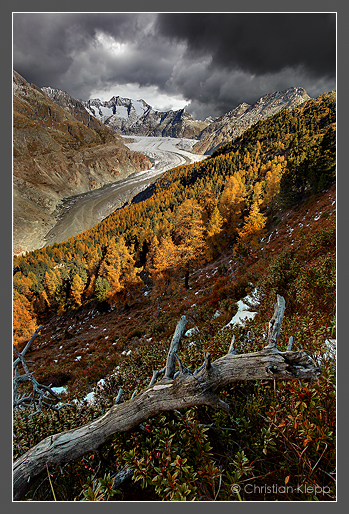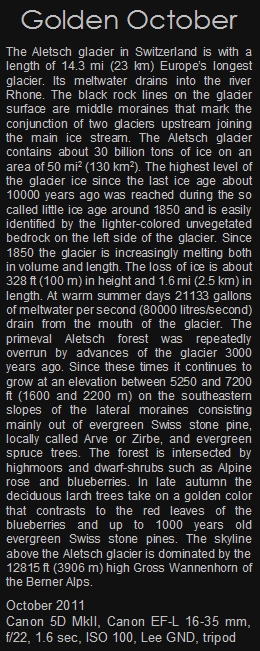

Golden October
The Aletsch glacier in Switzerland is with a length of 14.3 mi (23 km) Europe’s longest glacier. Its meltwater drains into the river Rhone. The black rock lines on the glacier surface are middle moraines that mark the conjunction of two glaciers upstream joining the main ice stream. The Aletsch glacier contains about 30 billion tons of ice on an area of 50 mi2 (130 km2). The highest level of the glacier ice since the last ice age about 10000 years ago was reached during the so called little ice age around 1850 and is easily identified by the lighter-colored unvegetated bedrock on the left side of the glacier. Since 1850 the glacier is increasingly melting both in volume and length. The loss of ice is about 328 ft (100 m) in height and 1.6 mi (2.5 km) in length. At warm summer days 21133 gallons of meltwater per second (80000 litres/second) drain from the mouth of the glacier. The primeval Aletsch forest was repeatedly overrun by advances of the glacier 3000 years ago. Since these times it continues to grow at an elevation between 5250 and 7200 ft (1600 and 2200 m) on the southeastern slopes of the lateral moraines consisting mainly out of evergreen Swiss stone pine, locally called Arve or Zirbe, and evergreen spruce trees. The forest is intersected by highmoors and dwarf-shrubs such as Alpine rose and blueberries. In late autumn the deciduous larch trees take on a golden color that contrasts to the red leaves of the blueberries and up to 1000 years old evergreen Swiss stone pines. The skyline above the Aletsch glacier is dominated by the 12815 ft (3906 m) high Gross Wannenhorn of the Berner Alps.
October 2011
Canon 5D MkII, Canon EF-L 16-35 mm, f/22, 1.6 sec, ISO 100, Lee GND, tripod




















